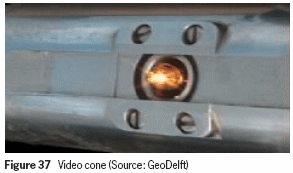Chapter 4
Part 3: Special cones: other cones
Video Cone
| VIDEO CONE 4.15 The video cone (Figure 37) – in appearance, identical to the hydrocarbon cone described in Section 4.11 on page 37 – is a new and innovative soil investigation technique to provide images of subsoil. The cone is pushed into the ground with standard cone penetration equipment. The video cone, developed by GeoDelft in 1998, consists of a stainless steel cone, measuring 60 mm in diameter and 1 m in length. |  |
| The camera window of sapphire glass is located some 30 cm behind the cone tip. The viewing glass is small, measuring 5 x 7 mm. A lamp, mirror and video camera are fitted behind the glass. The camera is connected via an electronic signal cable to a video recorder and monitor in the test truck. Video recording The video cone is pushed through the soil, ideally at a speed of 5 mm/sec, using extension tubes with a diameter of 55 mm. Continuous, and simultaneous video recordings of the subsoil are made. Online viewing is also possible on a monitor. A microphone can be connected to the sound channel of the video to provide a commentary. During soil penetration, a light beam shines through the viewing glass directly onto the adjacent soil, enabling the camera to record an image. Images The images (exemplified by Figures 38, 39 and 40, on the opposite page, of clay, sand and chalk) show the soil with a resolution of 752 x 582 pixels. Presentation of the images from the surface of the viewing glass to the monitor substantially magnifies the soil grains and particles. Magnification can be up to 100-fold, depending on the type of monitor. This method provides information which is not directly visible to the naked eye. For example, mineral particles such as shells can be easily distinguished from other mineral particles. Small voids, gas bubbles and contaminants are also readily visible. |

If used in combination with other soil penetration techniques, the video
|
